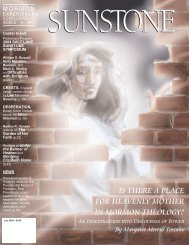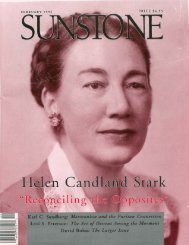Download Entire Issue PDF - Sunstone Magazine
Download Entire Issue PDF - Sunstone Magazine
Download Entire Issue PDF - Sunstone Magazine
Create successful ePaper yourself
Turn your PDF publications into a flip-book with our unique Google optimized e-Paper software.
S U N S T O N E<br />
sented to the execution of such a plan, as it is represented by the memorialist,<br />
that to be able to effect it, the vessel carrying the materials must approach<br />
within three or four hundred feet of the vessel to be attacked. The memorialist<br />
supposes that fifty thousand dollars would be necessary to carry his plan into<br />
execution; the committee taking into consideration the present situation of the<br />
finances ... think it would be inexpedient at this time to authorize an appropriation<br />
for the purpose proposed by the memorialist.”<br />
149. Sidney Rigdon sermon on 6 April 1844, compiled on 24 April 1844<br />
by Thomas Bullock, LDS Archives, with complete transcription in Quinn’s research<br />
files, Beinecke Library; deleted from the published report.<br />
150. Church History in the Fulness of Times, 281, for photograph of the<br />
“six-shooter” Joseph Smith used and the single-shot handgun he gave his<br />
brother Hyrum who declined to fire it. John Hay, “The Mormon Prophet’s<br />
Tragedy,” Atlantic Monthly 24 (December 1869): 675, identified three men who<br />
were shot by Joseph Smith: John Wills in the arm, William Vorhees in the<br />
shoulder, and William Gallagher in the face. Hay was a son of Charles Hay, a<br />
surgeon of the Carthage militia and apparently a member of the mob. Church<br />
History in the Fulness of Times, 282, agrees that Smith wounded three men.<br />
151. Origins of Power, 176–81; Marshall Hamilton, “From Assassination<br />
to Expulsion: Two years of Distrust, Hostility, and Violence,” in Launius and<br />
Hallwas, Kingdom on the Mississippi Revisited, 214–30; John E. Hallwas and<br />
Roger D. Launius, eds., Cultures in Conflict: A Documentary History of the<br />
Mormon War in Illinois (Logan: Utah State University Press, 1995).<br />
152. John Smith (former Danite) patriarchal blessing to John Smith (b.<br />
1832), 22 January 1845, quoted in Irene M. Bates, “Patriarchal Blessings and<br />
the Routinization of Charisma,” Dialogue: A Journal of Mormon Thought 26 (Fall<br />
1993): 12, 12n45, 21; Hosea Stout diary, 27 September 1845, in Juanita Brooks,<br />
ed., On the Mormon Frontier: The Diary of Hosea Stout, 1844–1861, 2 vols. (Salt<br />
Lake City: University of Utah Press, 1964), 1: 76; Elden J. Watson, ed., MANU-<br />
SCRIPT HISTORY of Brigham Young, 1846–1847 (Salt Lake City: By the author,<br />
1971), 480 (24 February 1847); Elisha H. Groves patriarchal blessing to<br />
William H. Dame, 20 February 1854, in Harold W. Pease, “The Life and Works<br />
of William Horne Dame,” M.A. thesis, Brigham Young University, 1971, 64–66;<br />
Groves patriarchal blessing to William Leany, 23 February 1854, in Leany autobiography,<br />
8, typescript in Utah State Historical Society; “DISCOURSE By<br />
Jedediah M. Grant, Tabernacle, G.S.L. City, March 12th 1851 [1854],” Deseret<br />
News [weekly], 27 July 1854, [2]; “REMARKS By President J. M. Grant,<br />
Bowery, Sunday Morning, Sept. 21, 1856,” Deseret News [weekly], 1 October<br />
1856, 235; Elisha H. Groves patriarchal blessing to Joseph Fish, 30 January<br />
1857, in Paul H. Peterson, “The Mormon Reformation,” Ph.D. dissertation,<br />
Brigham Young University, 1981, 192; Isaac Morley (former Danite) patriarchal<br />
blessing to Philip Klingensmith, 28 May 1857, in Anna Jean Backus,<br />
Mountain Meadows Witness: The Life and Times of Bishop Philip<br />
Klingensmith (Spokane: Arthur H. Clark Co., 1995), 124; Journal of<br />
Discourses, 1: 73 (Hyde/1853), 1: 83 (B. Young/1853), 1: 97 (G.A.<br />
Smith/1851), 1: 108 (B. Young/1853), 3: 246–47 (B. Young/1856), 4:<br />
49–51 (J.M. Grant/1856), 4: 53–54 (B. Young/1856), 4: 173–74<br />
(Kimball/1857), 4: 219–20 (B. Young/1857), 4: 375 (Kimball/1857), 6:<br />
38 (Kimball/1857), 7: 20 (Kimball/1854), 7: 146 (B. Young/1859), 10:<br />
110 (B. Young/1857); Sacred Hymns and Spiritual Songs (Salt Lake City:<br />
Deseret News/George Q. Cannon, 1871), 73–74, 314, 332, 337, 385;<br />
Sessions, Mormon Thunder, 125–30, 211; John W. Welch and John<br />
William Maddox, “Reflections on the Teachings of Brigham Young,” in<br />
Susan Easton Black and Larry C. Porter, eds., Lion of the Lord: Essays on<br />
the Life & Service of Brigham Young (Salt Lake City: Deseret Book Co.,<br />
1995), 393 (which listed two of these sermons on “Blood<br />
Atonement”); Extensions of Power, esp. 246–57.<br />
153. Charles W. Penrose, Blood Atonement, As Taught By Leading<br />
Elders of the Church of Jesus Christ of Latter-day Saints (Salt Lake City:<br />
Juvenile Instructor Office, 1884), 35; Roberts, Comprehensive History,<br />
4: 126; Eugene England, Brother Brigham (Salt Lake City: Bookcraft,<br />
1980), 169, 182; Lowell M. Snow, “Blood Atonement,” in Ludlow,<br />
Encyclopedia of Mormonism, 1: 131; Ronald W. Walker review in<br />
Journal of Mormon History 20 (Spring 1994): 170, 173.<br />
154. Extensions of Power, 242–61; “OFFICIAL DECLARATION,”<br />
Deseret Evening News, 14 December 1889, [2]; James R. Clark, ed.,<br />
Messages of the First Presidency of the Church of Jesus Christ of Latter-day<br />
Saints, 6 vols. (Salt Lake City: Bookcraft, 1965–71), 3: 185, 186.<br />
155. Extensions of Power, 242, 245, 248–49, 257, 273. On these<br />
issues, also compare Will Bagley, Blood of the Prophets: Brigham Young<br />
and the Massacre at Mountain Meadows (Norman: University of<br />
Oklahoma Press, 2002) with Ronald W. Walker, Richard E. Turley Jr., and Glen<br />
M. Leonard, Massacre at Mountain Meadows (New York: Oxford University<br />
Press, 2008).<br />
156. Melvin T. Smith, “Response to Paper by D. Michael Quinn,” John<br />
Whitmer Historical Association 2002 Nauvoo Conference Special Edition, 187.<br />
157. For statistics of polygamy in Utah, see Dean L. May, “People on the<br />
Mormon Frontier: Kanab’s Families of 1874,” Journal of Family History 1<br />
(Winter 1976): 169–92; James E. Smith and Phillip R. Kunz, “Polygyny and<br />
Fertility in Nineteenth-Century America,” Population Studies 30 (September<br />
1976): 465–80; Phillip R. Kunz, “One Wife or Several?: A Comparative Study of<br />
Late Nineteenth Century Marriage in Utah,” in Thomas G. Alexander, ed., The<br />
Mormon People: Their Character and Traditions (Provo, Utah: Brigham Young<br />
University Press, 1980), 53–73; Larry Logue, “A Time of Marriage: Monogamy<br />
and Polygamy in a Utah Town,” and Lowell “Ben” Bennion, “The Incidence of<br />
Mormon Polygamy in 1880: `Dixie’ versus Davis Stake,” Journal of Mormon<br />
History 11 (1984): 3–26, 27–42; Marie Cornwall, Camela Courtright and Laga<br />
Van Beek, “How Common the Principle?: Women as Plural Wives in 1860,”<br />
Dialogue: A Journal of Mormon Thought 26 (Summer 1993): 139–53; Kathryn<br />
M. Daynes, More Wives Than One: Transformation of the Mormon Marriage<br />
System, 1840–1910 (Urbana: University of Illinois Press, 2001), 100–01 (for<br />
percentages from her research about Manti). For the publicly stated emphasis<br />
of LDS leaders that plural marriage was the required norm, see Daynes (72–73)<br />
and B. Carmon Hardy, Doing the Works of Abraham: Mormon Polygamy: Its<br />
Origins, Practice, and Demise (Norman, OK: Arthur H. Clark, 2007).<br />
158. Ray Allen Billington, The Protestant Crusade, 1800–1860: A Study of<br />
the Origins of American Nativism (New York: Rinehart, 1952); David Brion<br />
Davis, “Some Themes in Counter Subversion: An Analysis of Anti-Masonic,<br />
Anti-Catholic and Anti-Mormon Literature,” Mississippi Valley Historical<br />
Review 57 (September 1960): 205–24; Leonard J. Arrington and Jon Haupt,<br />
“Intolerable Zion: The Image of Mormonism in Nineteenth-Century American<br />
Literature,” Western Humanities Review 22 (Summer 1968): 243–60; Gary L.<br />
Bunker and Davis Bitton, The Mormon Graphic Image, 1834–1914: Cartoons,<br />
Caricatures, and Illustrations (Salt Lake City: University of Utah Press, 1983);<br />
Craig L. Foster, “Anti-Mormon Pamphleteering in Great Britain, 1837–1860,”<br />
M.A. thesis, Brigham Young University, 1989; William O. Nelson, “Anti-<br />
Mormon Publications,” in Ludlow, Encyclopedia of Mormonism, 1: 115–32;<br />
Craig L. Foster, “Victorian Pornographic Imagery in Anti-Mormon Literature,”<br />
Journal of Mormon History 19 (Spring 1993): 115–32; Terryl L. Givens, The<br />
Viper on the Hearth: Mormon Myths and the Construction of Heresy (New York:<br />
Oxford University Press, 1997); any sample one might choose on the Internet<br />
of Evangelical diatribes against Mormonism.<br />
OCTOBER 2011 PAGE 37

















